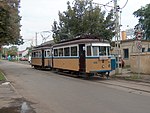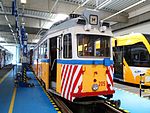Debrecen tram
| Debrecen tram | |
|---|---|
| CAF Urbos , the most common type of vehicle in Debrecen | |
| Basic information | |
| Country | Hungary |
| city | Debrecen |
| opening | 1880 |
| electrification | March 16, 1911 |
| operator | DKV Zrt. |
| Infrastructure | |
| Route length | 8.8 km |
| Gauge | 1435 mm ( standard gauge ) |
| Power system | 600 V DC overhead line |
| Stops | 23 |
| Depots | 1 |
| business | |
| Lines | 2 |
| vehicles | 11 KCSV6 18 CAF Urbos 3 |
| Network plan (2015) | |
The Debrecen tram has the smallest tram network in Hungary . It is operated by Debreceni Közlekedési Vállalat (Debreziner Verkehrsgesellschaft; DKV). From the network of the second largest Hungarian city Debrecen , which originally comprised six lines, one line (main station ↔ university) remained after massive closures in the 1970s, which is now served with modern vehicles at frequent intervals. After the turn of the millennium, the network grew again, so that a second line went into operation on February 26, 2014.
history
The history of the Debrecen tram began in 1880 when a plan to build a narrow-gauge horse-drawn tram was first drawn up in the city . The rapidly developing city wanted to use the train to facilitate both passenger traffic and freight traffic, particularly to the István steam mill (at today's Malompark). After lengthy negotiations, the city signed a contract with Joseph Lehmann to build a standard-gauge steam tram between the train station and the spa. Passenger traffic on this line began on October 2, 1884. In the meantime, the Debreczeni Helyi Vasút Rt. (DHV) built a horse-drawn railway line from the Hotel Goldener Stier (today: Kossuth tér) via Hatvan utca, the Kleinbahnhof (today: Segner tér) to the cattle market (today: Böszörményi út) Opened October 1888. On September 19, 1896, another horse-drawn railway line was opened. It ran over Kossuth utca and Attila tér to the tobacco factory (Vagóhid utca 2). Due to the increasing demand for transport, the Debreczen-Hajdúsámsoni Hév suburban railway was opened in 1906, which ran from the small station via the Böszörményi út and Füredi út to the Pallag district and on to Hajdúsámson. To the north of what is now Bem tér, the tram and suburban railway ran on the same route, but due to the increasing traffic, a bypass route for the suburban railway was built in 1910 in the area of today's Botanical Garden and the clinics.
On March 16, 1911, the first electric tram was put into operation in Debrecen on the route from Kossuth Square via Csapó Street to Tüzérlaktanya Gate on Sámsoni Street. In 1912, the route to the tobacco factory was extended over a bridge over the Debrecen-Nyíregyháza railway line along Vagóhid utca to the slaughterhouse. The tram network thus reached a length of 12.3 kilometers in 1924.
Between the two world wars , the expansion of the tram network in Debrecen continued: the small train, which had meanwhile been extended to Nyírbátor, was also electrified in 1924 between the terminus Stadtwald and Pallag and trams traveled to the local business academy. In 1925 a branch was built to the main university building. In 1927 the urban forest loop that still exists today was built. The route to Tüzérlaktanya Gate was extended in 1934 along Kassai út to Gate 1 of the Community Cemetery (Köztemető), and in 1939 the main entrance to the cemetery was reached via Benczúr Gyula utca. In 1943 the route to the cattle market was extended to Nyulas. At the end of World War II, there were already more than 10 tram lines in the city.
From 1950 to 1962 the Debrecen tram network consisted of the following lines:
| line | Line route |
|---|---|
| 1 | Central Station (Nagyállomás) ↔ University (Egyetem) |
| 3 | City forest (Nagyerdő) ↔ Pallag |
| 4th | Town Hall (Városháza) ↔ Slaughterhouse (Közvágóhíd) |
| 5 | Hotel Golden Bull (Arany Bika szálloda) ↔ Nyulas |
| 6th | Hotel Golden Bull (Arany Bika szálloda) ↔ Community Cemetery (Köztemető) |
| 7th | City forest (Nagyerdő) ↔ Lung Sanatorium (Tüdőszanatórium) |
In 1962, the inner-city section of line 4 was moved from Kossuth-Straße to Béke-Straße (today: St. Anna-Straße). Until then, the end point of the line was right in the center of the city.
The number of passengers rose sharply in the decades after the Second World War: in 1969, 47.4 million passengers were carried. Nevertheless, the transport policy in Debrecen after 1968 pursued the goal of closing the single-track tram lines. Lines 3 and 7 to Pallag and to the lung sanatorium were the first to be shut down in 1970. In 1971 line 6 to the cemetery disappeared, in 1973 line 5 to Nyulas and the last line to go to the slaughterhouse in 1975. Until the new line 2 (see below) went into operation on February 26, 2014, the Debrecen tram network consisted only of line 1.
Lines
| line | Line route | length | Hold | Travel time | vehicles |
|---|---|---|---|---|---|
| 1 | Central Station ↔ Egyetem (University) | 4.4 km | 13 | 20 min | KCSV6, CAF Urbos 3 |
| 2 | Central Station ↔ Doberdó utca (Doberdóstraße) | 6 km | 16 | 22 min | CAF Urbos 3 |
| Lines 1 and 2 | |||||||||||||||||||||||||||||||||||||||||||||||||||||||||||||||||||||||||||||||||||||||||||||||||||||||||||||||||||||||||||||||||||||||||||||||||||||||||||
|---|---|---|---|---|---|---|---|---|---|---|---|---|---|---|---|---|---|---|---|---|---|---|---|---|---|---|---|---|---|---|---|---|---|---|---|---|---|---|---|---|---|---|---|---|---|---|---|---|---|---|---|---|---|---|---|---|---|---|---|---|---|---|---|---|---|---|---|---|---|---|---|---|---|---|---|---|---|---|---|---|---|---|---|---|---|---|---|---|---|---|---|---|---|---|---|---|---|---|---|---|---|---|---|---|---|---|---|---|---|---|---|---|---|---|---|---|---|---|---|---|---|---|---|---|---|---|---|---|---|---|---|---|---|---|---|---|---|---|---|---|---|---|---|---|---|---|---|---|---|---|---|---|---|---|---|
|
|||||||||||||||||||||||||||||||||||||||||||||||||||||||||||||||||||||||||||||||||||||||||||||||||||||||||||||||||||||||||||||||||||||||||||||||||||||||||||
line 1
Line 1 runs in a south-north direction from the main train station to the university and opens up the city center with the district building (Megház), the Small Reformed Church (Kistemplom), the Town Hall (Városháza) and the Great Reformed Church (Nagytemplom). In addition, the Debrecen Plaza shopping center, the Fórum Debrecen shopping center, the Tanítóképző Főiskola University of Education, the Aquaticum thermal and wellness baths and the clinics are served. The line is completely double- tracked. At the northern end of the route, a large single-track loop will be passed.
Line 2
For several years there have been plans to replace bus lines 31 and 32 with a tram line. It runs between the main train station and Doberdó utca. It opens up the settlements Vénkert and Újkert and leads over Dózsa György út and Thomas Mann utca. Between the main train station and the Kálvin tér stop, she uses line 1 and branches off there in a westerly direction into Hunyadi János utca. In December 2008, the European Union approved a funding application for the implementation of this major project. The first construction work began on September 15, 2010. Completion was originally planned for December 31, 2012.
By March 2014, a total of 18 Urbos low-floor articulated multiple units had been procured for Line 2 from the Spanish manufacturer CAF . The total investment volume for the route and vehicles was 17.6 billion forints . In August 2013 the cars 511 to 513 had already been delivered to Debrecen. Test drives with cars 511 and 512 took place on the section of the new line between Kálvin tér and Malompark (Nádor utca), which was then passable. From December 20, 2013, regular test drives will be carried out on the entire route. Line 2 opened on February 26, 2014.
vehicles
KCSV6
The Budapest company Ganz built eleven KCSV6 trams for the Debrecen tram between 1993 and 1997. They were the last new development of a tram in Hungary. Only the eleven railways for Debrecen were built of this type. Its capacity is 163 passengers, including 28 seats. They reach a top speed of 60 kilometers per hour. They are 21.7 meters long and have a drive power of 4 × 85 kilowatts.
CAF
As part of the tramway project Line 2 , a total of 18 vehicles were ordered from the Spanish company CAF with financial support from the EU , they mainly run on Line 2, and some cars are used in addition to the KCSV6s as a supplement.
One car is 32.5 m long and 2650 mm wide.
Museum car
- For the centenary of the Debrecen tram in 1984, DKV from Budapest bought the historic 1884 + 1984 twin railcars.
- After 2000, DKV bought the two-axle Budapest timber construction car HTw260, which was built in 1913. Originally it had the number BVVV 480, then BSzKRt 2944, then FVV / BKV 2964. In 1986 it was sold to Amsterdam.
- The car type FVV CSM is nicknamed "Bengáli" and was built between 1963 and 1984 for Debrecen as well as for Budapest , Miskolc and Szeged . This three-part bi - directional articulated railcar was designed by the Budapest transport company BKV, and from 1963 it was built in the central workshop Árpád Füzesi . In 1965 the production of this type of car was relocated to the DKV depot in Debrecen. It is 22.6 meters long, its capacity is 210 people, of which 38 can be carried in seats. Because of the low drive power of 2 × 52 kilowatts, this type only reaches a top speed of 40 kilometers per hour. The "Bengális" were the only tram series in the city until the arrival of the type KCSV6, and after the new cars were put into operation in 1997, this outdated type could not be banned from the cityscape, some cars were still in use until 2014 found in line operation, they could be replaced by the CAF Urbos.
Vehicle types at a glance
| image | designation | Number (originally) | Number (currently) | Wagon number range | Construction year | in operation | Lines |
|---|---|---|---|---|---|---|---|
| Line vehicles | |||||||

|
CAF Urbos 3 |
18th | 511-528 | 2013-2014 | Since 2014 | 1, 2 | |

|
KCSV – 6 | 11 | 9 (+2 inoperable cars) |
500-510 | 1993, 1997 | since 1994 | 1 |
| Museum vehicles | |||||||

|
FVV CSM Bengáli |
32 | 1 | 281-294 381-386 481-492 |
1962-1978 | 1962-2014 | As a line vehicle on Line 1 and since then nonexistent branch lines, as a museum vehicle on Lines 1 and 2 |

|
Type L | ? | 1 | 260 | 1911 - 19 ?? since 2007 |
||

|
2500 series | 1 twin railcar (inoperative for years) |
1884 + 1984 | 1984 óta | The type was never in regular service in Debrecen, as a museum car it was only used on line 1. | ||
| other vehicles | |||||||

|
UV | 1 | 205 | Not allowed to transport passengers | |||
Depot
The depot is not located directly on Line 1, but can be reached from the terminus at the main train station via an operating route through Ispotály Street. The entrance is on Salétrom Street. The depot is also used for trolleybuses, the entrance for the buses is further north, also on Salétrom Street.
Web links
- Official website of the operator DKV (Hungarian, English)
- Timetables (Hungarian)
- Project website for tram line 2 (Hungarian, English)
- History of the Debrecen tram on the website of the Hungarian Passenger Association VEKE (Hungarian)
Individual evidence
- ↑ Delay of tram line 2 . Debrecen.hu. October 9, 2009. Retrieved May 11, 2012. (Hungarian)
- ↑ Spanish trams on the move . 2-esvillamos.hu. October 11, 2009. Retrieved May 11, 2012. (Hungarian)





